Chicken Karaage (唐揚げ) is a Japanese-style fried chicken, and it is one of the most popular Japanese dishes. It is a great appetizer to go with drinks, a family-friendly dinner entree, and a perfect item for a Bento lunch box. Chicken is marinated well before coated lightly with flour and starch, and deep fried. With simple ingredients you can find anywhere, it is very easy to make Karaage at home.
What is Karaage?
Karaage is a cooking method, and it means deep fried food with no batter in Japanese. Unlike Tonkatsu or Tempura that are breaded or dipped in batter, Karaage is lightly coated with flour and starch, which gives a lighter and crispier texture. While any meat, seafood, or vegetables can be cooked this way, Karaage most often means Japanese fried chicken.
You can get Karaage absolutely anywhere in Japan. Izakaya Japanese bars serve a lot of little appetizers (like Tapas restaurants), and Karaage is a staple dish there. Local diners, Bento stores, and even Chinese restaurants all have their versions of Karaage. Hot delis in supermarkets have freshly fried chicken pieces for people to take home. Convenience stores in Japan sell Karaage as hot snacks in the hot deli boxes next to the registers. And it’s one of their best seller items, such as “Famichiki” at Family Mart and “L-Chiki” at Lawson.
Although you can find Karaage in many places in Japan, Karaage is still one of the most beloved home cooked meals. Piping hot, freshly fried Karaage is so good, and we definitely recommend making it yourself.
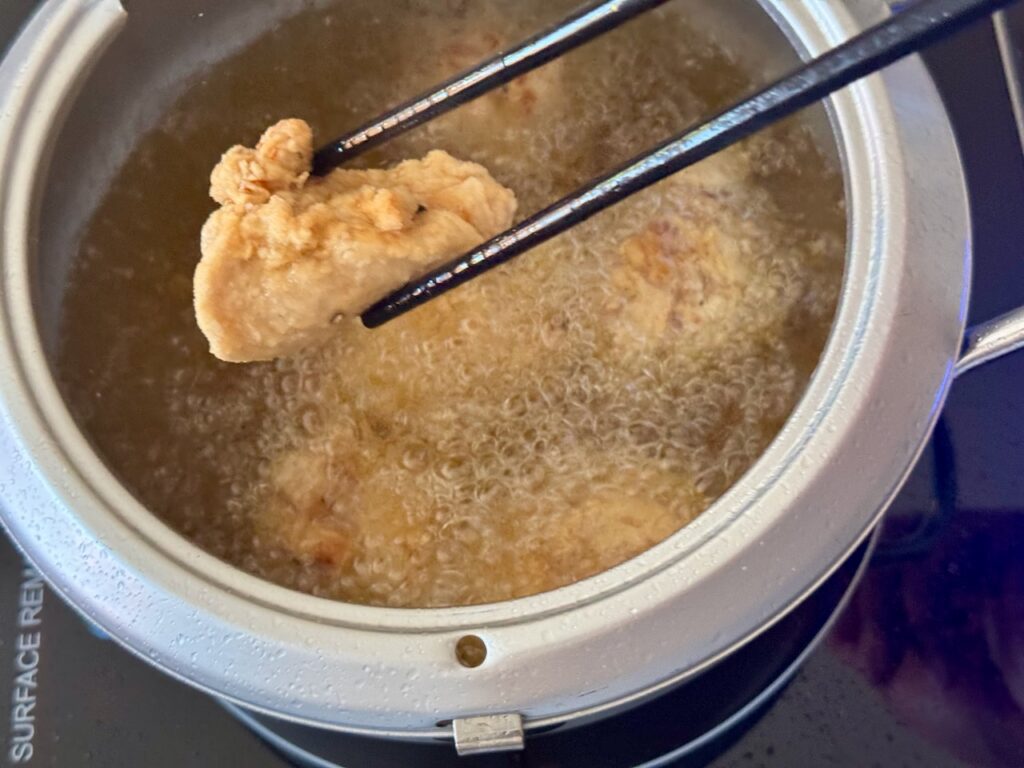

Karaage Ingredients
- Meat: Chicken thighs are the most common, but other parts of chicken such as breast and wings can be used. Other meat, seafood, and vegetables can be used for Karaage. See Karaage Variations below for more ideas.
- Marinade: The meat is marinated in the mixture of soy sauce, sake, and other seasonings such as ginger and garlic. If you like sweetness, add mirin or honey. We use freshly grated ginger and garlic, but you can also substitute with granulated ginger and garlic that are more convenient. Add some black or white peppers if you like a bit more spice.
- Coating: The marinated meat is coated with the combination of flour and starch. In this recipe, we use all-purpose flour and potato starch also called Katakuriko. You can also use cornstarch instead of potato starch. The ratio between the flour and starch can be adjusted to your liking. The starch will make the crust light and crispy, while the flour makes the meat juicy. You can add some spices such as black pepper, curry powder, or chilli powder for a kick.
- Dipping Sauce (optional): Karaage is already seasoned well and should be enjoyed as is, but you can arrange its flavor the way you like. A classic add-on flavor is fresh lemon juice, but Ponzu Sauce with chopped green onion is a great accompaniment too. Or simply serve Karaage with tangy Japanese mayonnaise sprinkled with Shichimi red pepper on the side.
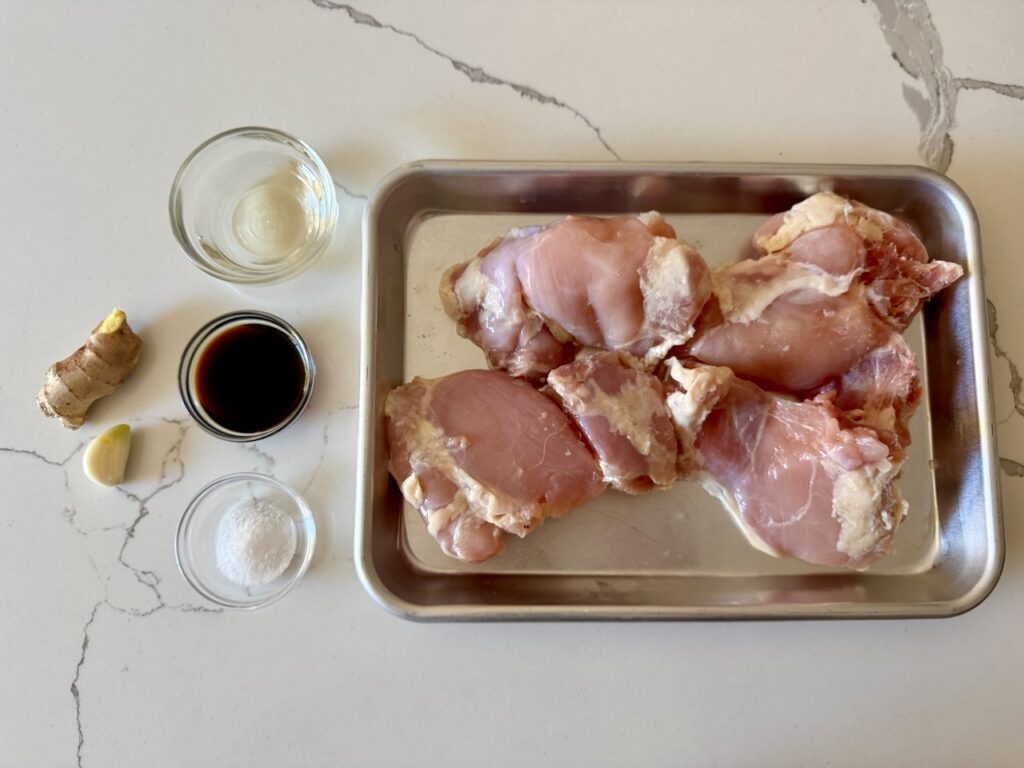
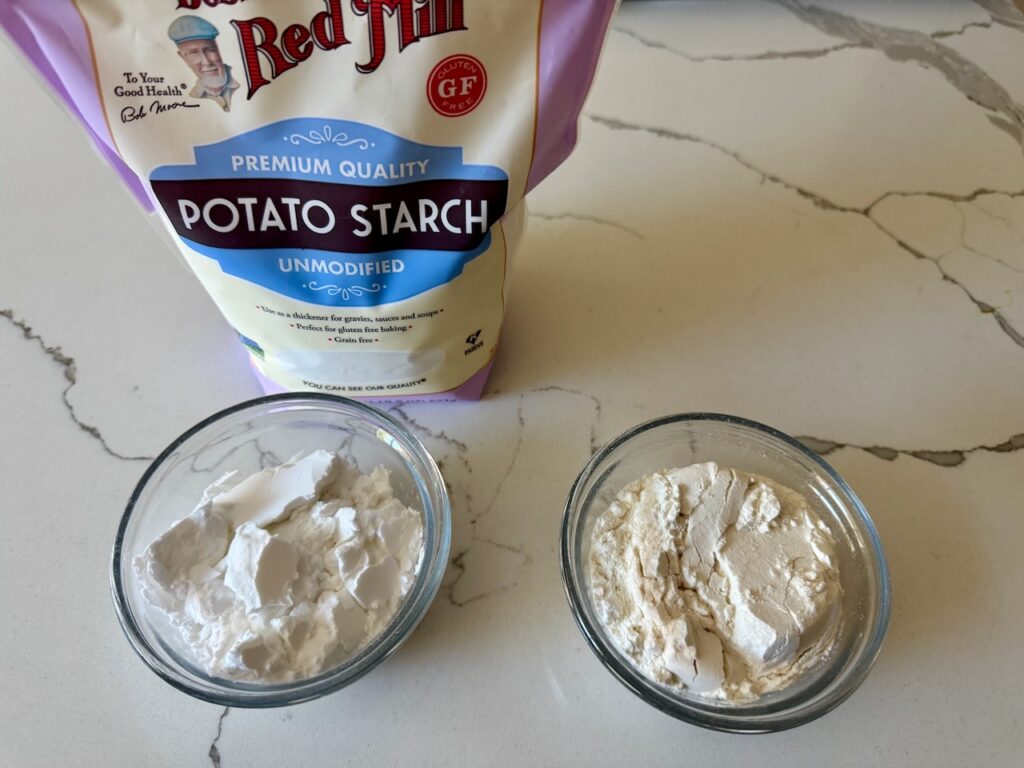
Short Video
A full recipe video is also available in the recipe box below and on our YouTube channel.
Karaage Variations
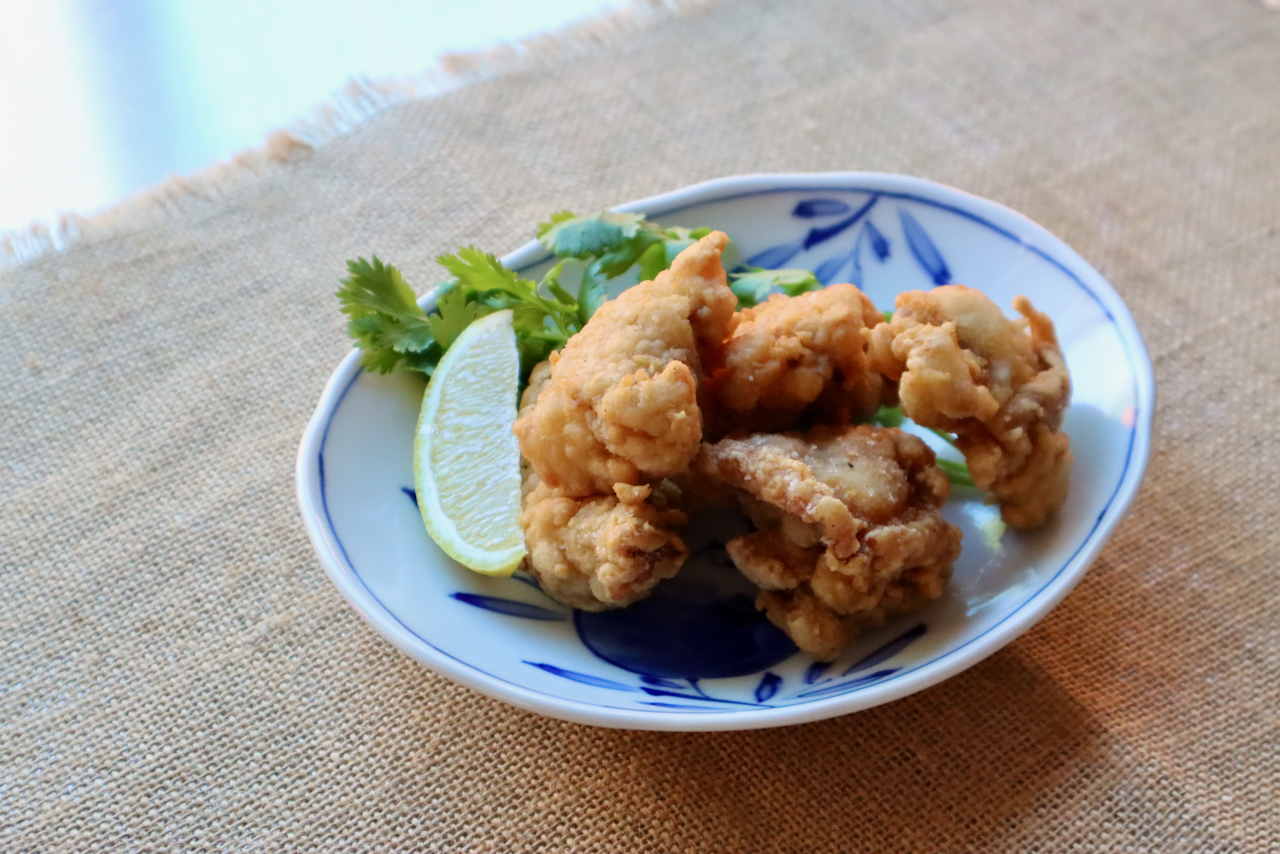
Karaage Recipe
Equipment
Ingredients
- 4 chicken thighs
- 2 Tbsp Sake
- 1 Tbsp Soy Sauce
- 1/2 tsp salt
- 1-2 tsp garlic (grated)
- 1-2 tsp ginger root (grated)
- 1/2 cup all purpose flour
- 1/2 cup Katakuriko potato starch (or corn starch)
- deep-frying oil
Instructions
- Cut each chicken thigh into 3-4 pieces. In a medium size bowl, mix Sake, Soy Sauce, salt, garlic and ginger with chicken. Let it sit for 1/2-1 hour.
- Mix flour and corn starch in another bowl. Coat marinated chicken pieces with flour mixture.
- Heat oil at medium high heat (350F). Deep-fry chicken for 6-8 minutes or until it's cooked through.
Video
Notes
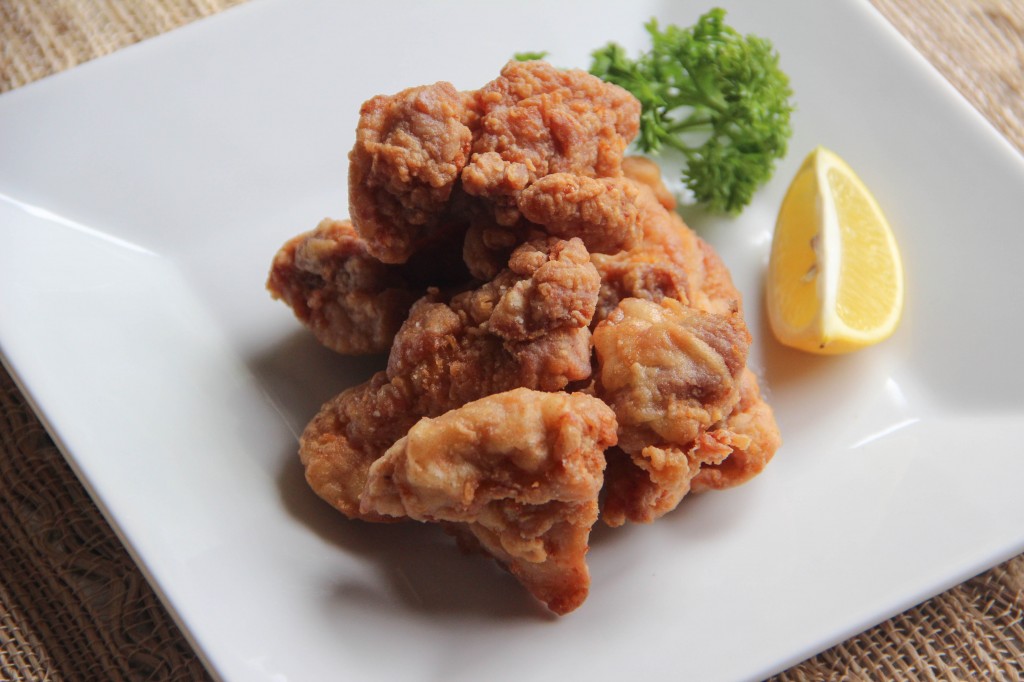
This recipe was originally published in December 2012. The post was updated on April 7, 2025 with more useful content, new photos and a short video.
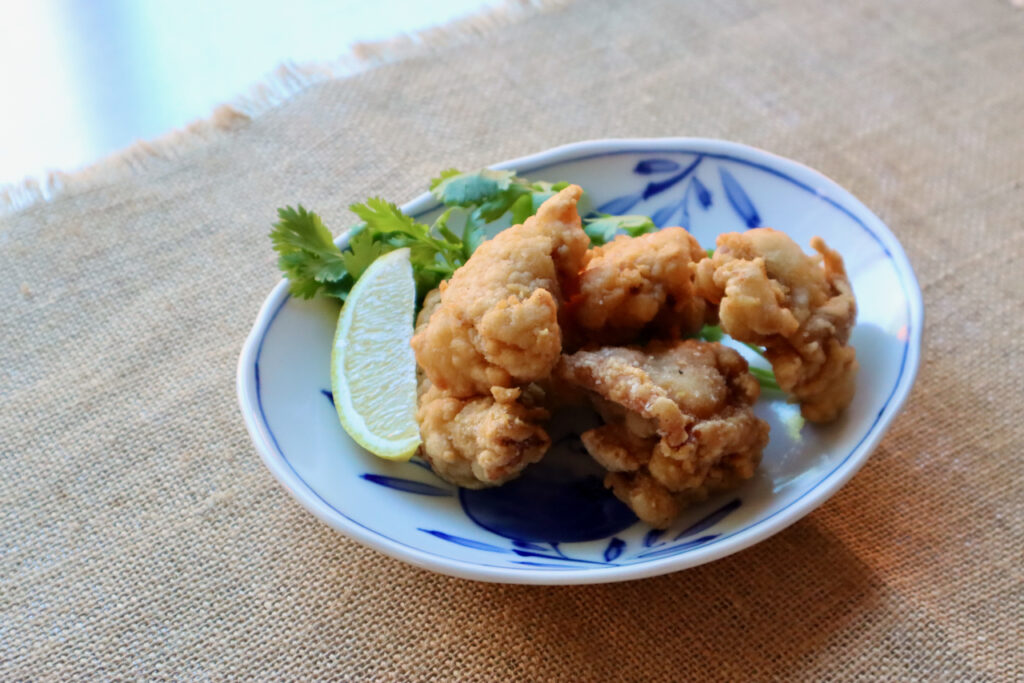
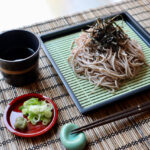
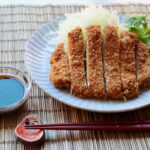
41 Comments
Hi you forgot to tell us what to do with the Ginger & garlic, I suspect include it in the marinade. Thanks, just thought I’d let you know.
Lii
You are right! thanks for pointing that out.
in the Ingredients portion. it says garlic and ginger should be grated.. so it will mix to marinade..
yeah they did it says mix sake soy salt and garlic and ginger duh
esasba,
thanks for your comment! I forgot to include some ingredients in the written recipe.
Hi,
Just wondering can you use Mirin instead of sake?
Thanks.
Jamie,
it tastes a little sweeter, but you can.
can i make this for my 8th grade middle school even though it uses sake
kevin,
yes, alcohol will evaporate while cooking.
I don’t drink wine or bear.Is there anything non-alcoholic I can use instead of the sake?
matty,
you can omit sake in Karaage.
Thanks for the recipe, karaage wa ume desu.
But the coating did not become crispy after 7-8 min.
Do you have a guess about what i could have done wrong.
Arigatogosaimasu.
Mike,
Thanks for trying our karaage recipe! Thicker coating of flour may help.
Increase the temperature. If i is too cold it will not crisp, but become a soggy coating of grease. Also allow the oil time to heat up (if in doubt, use one piece as a tester)
I don’t have sake, what other alternatives do you have?
Raika,
just omit it.
You can substitute cooking sherry for Sake. Or use Mirin.
Great karaage recipe, great dish, great video, nice and simple and not stupid!!!…but cooking time is 20 minutes not 20 hours…just a tip for beginner cooks!…arigato…
Cat,
thanks for pointing that out!
What do you think about adding some sesame oil?
mari,
sounds good!
I’ve never heard of karaage without eggs.
Sue,
this is a pretty typical Karaage recipe, and now you know the new way to make it! Let us know the difference if you make our version.
Did you by any chance confused karaage and chicken katsu? 😊
great recipe! instead of the flour and corn starch, i used potato starch. i didn’t write down all the ingredients and my friend told me potato starch is used, so while rushing to shop i went ahead and grabbed potato starch instead. it came out really crispy, even through the next day! (:
Janine,
potato starch is good to use for Karaage, it is actually more authentic Japanese way of making it (a lot of us outside Japan may not access to potato starch, so we substituted).
If we can’t get ahold of minced garlic and ginger would ground ginger and garlic powder be a good substitute?
Bobby,
fresh ginger and garlic are the best for the flavor, but can be substituted with powder.
could we storage the floured chicken in the fridge to fry it the next day? and how long could we storage it?
You can keep the marinated chicken in the fridge for a day, but we recommend frying it soon after you flour the chicken.
I made this last week and I loved it! I was wondering next time I make this if I could fry them in a cast iron skillet instead of a pot?
I’m looking forward to try many more of your fantastic recipes! 🙂
Best,
Matt
Hello, I am loving trying your recipes! I currently live in Japan and it is a great help with learning how to cook!
This was a very oishii recipe, though i didn’t have sake. Will make again. Thank you for sharing it with is.
Hi, umm what can I do to replace sake? My place here doesn’t sell sake.
Daryl,
you can just omit it.
I thought your suppose to use potato starch not corn as it is too crispy and hard.
Karaage lover,
you’re right, Katakuriko (potato starch) is better! You could substitute with corn if you don’t have it.
I’ve tried this recipe dozens of times and while the karaage comes out tasting good, it’s never quite right. The batter never bubbles and crisps like other karaage i’ve eaten, and it kind of just flakes off the chicken. What am I doing wrong!?
How much weight are in 4 chicken thighs?
I just made this for my family and it was a hit. I love the flavor especially the sake. It’s very subtle but adds to the flavor.
if I do not use or alcohol sake, if the taste karaage that I make will be fine?